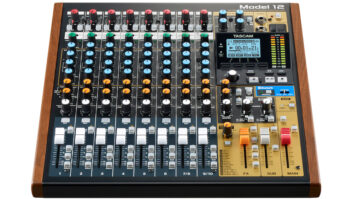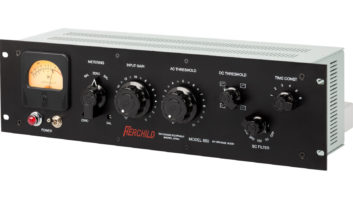Aphex has a decades’ long legacy in developing industry-standard dynamics controllers for critical recording, broadcast and mastering applications. And, in 1995, when the company branched out into the mic preamplification realm, the result was the Model 107, an award-winning product featuring patented Reflected Plate Amplifier (RPA) circuitry. The RPA approach offered all of the advantages of tube technology, without the weight, bulk and fragility common to conventional tube designs.
Two years ago, Aphex debuted its Model 1100, a high-end, high-performance RPA mic preamp/96kHz A/D converter, which drew widespread acclaim for its astounding -135dB noise specs and transparent MicLim® circuit that essentially eliminated the fear of transient overloads. Unfortunately, the 1100’s $2,500 price kept it out of the mainstream. Now, with the launch of the Model 207, Aphex offers an RPA tube preamp with MicLim, low -129dB noise specs and a few new tricks as well, but at a rock-bottom retail of $649.
Housed in a single-rackspace chassis, the 207’s controls are laid out cleanly, set back into a thick aluminum slab front panel. The internal power supply (no wall warts!) automatically handles any AC input from 100 to 240 volts. Each channel has a ¼-inch direct box input for high-impedance, instrument-level signals, along with backlit illuminated switches for 48VDC phantom power, polarity (“phase”), -20dB pad, low-cut filter and MicLim. A continuously variable gain control sets input gain, and output is monitored by dual 10-segment LED headroom meters. Each channel also has an output gain pot, recessed into the front panel, providing fine adjustments to match your particular system.
Speaking of outputs, the back panel has both XLR and ¼-inch TRS balanced connectors and a switch for setting outputs to either -10 dBV or +4 dBu. Also on the rear are the XLR mic inputs and ¼-inch TRS jacks for inserting outboard gear after the low-noise, discrete NPN gain stage and MicLim, but before the low-cut filter and tube output stages.
The outputs handle balanced or unbalanced signals equally well, so operation is plug-and-go. The 207 shares certain upscale features from the high-end Model 1100, such as expensive, bifurcated, gold-contact relay switching on the -20dB pad and phase-reverse circuits, and a phantom power switch ramps up slowly to reduce thumps and is gentle on your mics. Another nice touch, the 207 mutes the outputs on power-up, and its power LED glows yellow until the tubes are sufficiently warmed up (about 40 seconds), at which point the LED changes to green, the outputs are unmuted and the unit is ready to go.
On all kinds of mics, condensers or dynamics, ranging from Neumann tubes to Shure SM-57s, the 207 offered excellent results. The unit’s ultra-clean output and 65 dB of gain was even ample with low-output mics like E-V RE-20 and Royer Ribbons. The 207’s RPA tube section adds a hint (about 0.02%) of desirable even-harmonic distortion, just enough to add a bit of color without an overly gushy “tubey” sound. The result is a velvety character with lots of detail, especially with low-level signals such as long decays picked up by distant room mics.
The 207’s low-cut filter is similar to that used in the Model 107. It’s a second-order, -12dB/octave design centered at 70 Hz, and includes a slight emphasis around 120 Hz to improve the low-end phase distortion and increase the perception of LF fullness, even when the low-cut filter is selected. The net overall effect is protection from nasty vocal blasts and popping “P” and “B” consonants, without the typical thin or feeble-sounding result that most low-cut filters yield. And, removing unwanted low-energy allows more headroom for the signals that you do want.
Certainly one of the 207’s strongest features is the MicLim peak limiter, which puts an optically coupled attenuator before the preamp and drives it via a peak detector from the preamp output, rather than the conventional approach of putting the limiter just before the output stage. This way, MicLim not only takes the mic’s self-impedance into account, but also the peak-limiting protection occurs before the insert point, so there’s no worry about overloading de-essers or other outboard gear connected to the 207. In every case, MicLim provided ultra-smooth, transparent limiting, which allowed plenty of punch without destroying transients.
Guitars and basses plugged into the instrument jacks sounded round and full, especially with the MicLim switched in. The overall — and unanimous — reaction I received from studio players was “don’t touch that switch” whenever I tried to turn off the MicLim to make A/B comparisons.
Retailing at $649, the Aphex 207 would be a great deal even without its MicLim overload protection and direct-box functions. However, once those are factored in, you’d be hard-pressed to find a better stereo preamp under $1,000. What you do with the extra $350 savings is up to you.
Aphex Systems, 11068 Randall St., Sun Valley, CA 91352; 818/767-2929; www.aphex.com.



